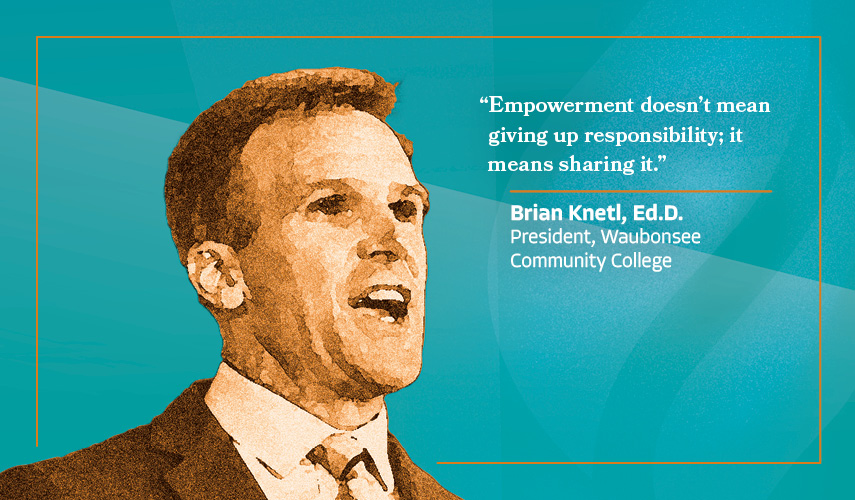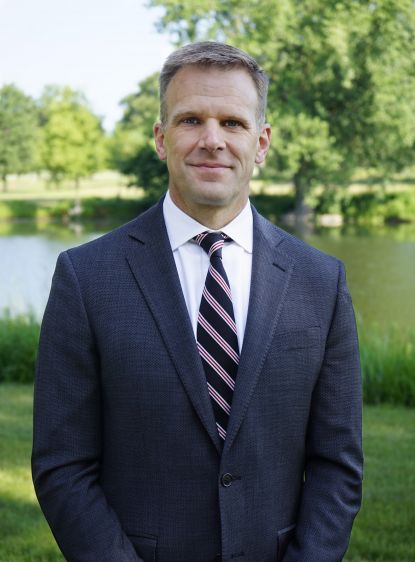
Courageous Leadership
Empowering Leadership
I believe that a leader’s success is not defined by the decisions they make alone, but by their ability to cultivate an environment where leadership is a shared responsibility, and others are trusted and empowered to lead alongside them. This philosophy has guided me from my early days as a new administrator to my current role as president of Waubonsee Community College. It has taken courage to adopt and stay committed to this empowering leadership style, but I have found that the most effective way to lead is by listening deeply, trusting my team, and fostering a culture where everyone has a stake in the institution’s success.
When I first stepped into leadership roles, I didn’t fully appreciate how formative my past experiences would be in shaping my leadership style. Early in my career, I was fortunate to work under leaders who empowered me, even long before I had earned the right to that trust. They handed me the reins to projects that were essential to the institution’s mission, allowing me to lead initiatives, experiment, and yes, sometimes fail. That trust and confidence, early on, helped me grow as an administrator and an educator. It’s a gift I’ve carried with me throughout my career, and it’s one that I’ve tried to pass on to others.

By Brian Knetl, Ed.D.,
President,
Waubonsee Community College (IL)
Changing the Culture for Empowerment
At Waubonsee, I knew from day one that I wanted to model the style of leadership that was so formative for me. I wanted to build a culture where people were empowered to make decisions, took ownership of projects, and contributed their unique insights and expertise.
One of the most important steps I took in this journey was conducting a 100-day listening tour when I first arrived. I called it the “Tour de Waubonsee”. It was a concept that reflected my love for cycling but also set the tone for how I wanted to lead. I spent those days listening and learning. I talked with faculty, staff, and students about their experiences, their frustrations, and their hopes for the future. On the 101st day, I held an all-college meeting to reflect back what I had heard. This wasn’t just an exercise in gathering information; it was about building trust and letting people know that their voices mattered. It was the first step toward reshaping the culture into one where collaboration and empowerment were not just ideals but lived realities.
I quickly learned that empowerment doesn’t happen overnight. In a room full of highly capable people, it can be tempting for a leader to be the one with all the answers. Yet, I believe it’s important to resist that temptation. Courage, in this context, means trusting others to lead, even when the stakes are high. It means stepping back so others can step forward. This style of leadership can feel risky, but I have seen firsthand the transformative results it produces.
For example, one of the proudest moments of my time at Waubonsee so far came from an initiative I didn’t even start. At a national conference, my team and I were discussing how our current policy on dropping students for non-payment wasn’t serving them well. The conversation was casual, and I simply asked some questions: “Why do we do it this way? Is there a more student-friendly approach?” A few weeks later, one of the administrators who had been part of that conversation took the initiative to form a team to review the policy. She didn’t wait for me to “direct her”—she took action. That team eventually brought their proposal to our President’s Cabinet, and we’re set to implement a new, more student-centered policy next semester.
This moment exemplified what I’ve been working toward: a culture where people feel empowered to act, where they don’t wait for the president’s permission to lead. It’s a small but significant example of how trusting others, even in seemingly small decisions, can lead to big changes.
Changing the Culture for Empowerment
At Waubonsee, I knew from day one that I wanted to model the style of leadership that was so formative for me. I wanted to build a culture where people were empowered to make decisions, took ownership of projects, and contributed their unique insights and expertise.
One of the most important steps I took in this journey was conducting a 100-day listening tour when I first arrived. I called it the “Tour de Waubonsee”. It was a concept that reflected my love for cycling but also set the tone for how I wanted to lead. I spent those days listening and learning. I talked with faculty, staff, and students about their experiences, their frustrations, and their hopes for the future. On the 101st day, I held an all-college meeting to reflect back what I had heard. This wasn’t just an exercise in gathering information; it was about building trust and letting people know that their voices mattered. It was the first step toward reshaping the culture into one where collaboration and empowerment were not just ideals but lived realities.
I quickly learned that empowerment doesn’t happen overnight. In a room full of highly capable people, it can be tempting for a leader to be the one with all the answers. Yet, I believe it’s important to resist that temptation. Courage, in this context, means trusting others to lead, even when the stakes are high. It means stepping back so others can step forward. This style of leadership can feel risky, but I have seen firsthand the transformative results it produces.
For example, one of the proudest moments of my time at Waubonsee so far came from an initiative I didn’t even start. At a national conference, my team and I were discussing how our current policy on dropping students for non-payment wasn’t serving them well. The conversation was casual, and I simply asked some questions: “Why do we do it this way? Is there a more student-friendly approach?” A few weeks later, one of the administrators who had been part of that conversation took the initiative to form a team to review the policy. She didn’t wait for me to “direct her”—she took action. That team eventually brought their proposal to our President’s Cabinet, and we’re set to implement a new, more student-centered policy next semester.
This moment exemplified what I’ve been working toward: a culture where people feel empowered to act, where they don’t wait for the president’s permission to lead. It’s a small but significant example of how trusting others, even in seemingly small decisions, can lead to big changes.
Embracing ‘Intelligent Failure
Of course, trusting your team doesn’t mean everything will go smoothly. There are risks to this approach to leadership. Empowered leadership often leads to challenges and mistakes, but I’ve learned to view those as opportunities to learn and grow. I talk often about what is referred to as “intelligent failure”—the idea that we should do our due diligence before taking risks, but we should also be willing to move forward, knowing we won’t always have all the answers. It takes courage to say, “Let’s try this, and if it doesn’t work, we’ll learn from it, and figure out how to fix it.” Empowered leadership is about creating a safety net, not by avoiding risk but by encouraging responsible risk-taking and learning from the results. That’s how we build resilience, both as individuals and as an institution.
Empowerment doesn’t mean giving up responsibility; it means sharing it.
The courage to lead with open ears and an open heart means being vulnerable. It means letting people know that while I’m the president, I don’t have all the answers, and I don’t need to. I surround myself with talented people who bring diverse perspectives, and I trust them to help guide the institution forward. Empowerment doesn’t mean giving up responsibility; it means sharing it. It means creating a space where others feel comfortable and supported stepping into leadership roles, knowing that their contributions are valued.
As I look toward the future, I’m committed to continuing this journey of empowering leadership. It’s not always easy. It takes time to build a culture of trust, and it requires constant reinforcement. But I’ve seen the results—better decisions, stronger relationships, and a more engaged community.

